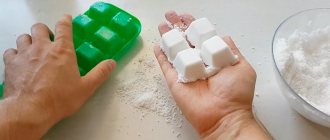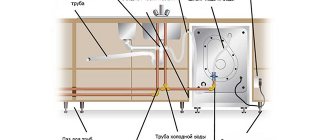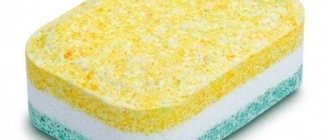Dishwashers have become a real godsend for modern housewives who want to spend more time in the evenings with their family and loved ones. In addition, these simple devices save water and electricity, which is very profitable considering utility prices. How long does it take for a dishwasher to clean? Everything directly depends on the cycle, but in any case, it will do it much faster and better, especially when it comes to washing cutlery after family feasts. Remember how many different types of dishes are usually left behind after gatherings; as a result, the housewife has to wash them under the cover of darkness, when all family members have long been asleep. Now you can simply load all the dishes into the tray and turn on the device, which will wash the most dirty plates and pots to a shine.
Loading order
The quality of cleaning depends on the correct loading of devices into the working compartment.
You can use several baskets for different types of dishes and a special tray for spoons and forks. For proper placement, adjust the level of the basket so that the water flow hits all items. Start loading from the bottom tier. Besides:
- Place large dirty items in the lower basket, and small ones in the upper basket;
- Place large utensils closer to the edge, and smaller ones closer to the middle of the basket;
- place the tray with spoons, forks, knives in the center, place them with the handle down;
- install pans with handles only horizontally so that they do not hit the ceiling of the compartment;
- Place all containers upside down only, so the flow of water will completely wash away the detergent;
- Place cups, glasses and glasses on the holders provided for this purpose.
Examples
Using the example of various dishwashers, it will be possible to set the washing duration in different modes.
ELECTROLUX ESF 9451 LOW
- In quick wash mode, the duration of the procedure at a water temperature of 60 degrees is 32 minutes.
- Intensive washing involves heating the water to 70 degrees. Cycle time is approximately 36 minutes.
- In the main operating rhythm, the machine completes all procedures in 105 minutes.
- The economical program requires 125 minutes of work.
AEG OKO FAVORIT 5270i
- A quick wash lasts 32 minutes.
- In the intensive wash program, the machine runs for 105 minutes.
- The main program continues to run for 98 minutes.
- The bioprogram ends after 97 minutes.
HANSA ZWM 4677 IEH
- A quick wash lasts 42 minutes.
- Express 60 lasts one hour.
- Gentle care requires spending 108 minutes.
- ECO mode lasts 162 minutes.
- Dishes in normal mode become clean in 154 minutes.
- Intensive mode ends after 128 minutes.
Gorenje GS52214W(X)
- A standard wash lasts 154 minutes.
- The duration of intensive work is 128 minutes.
- The delicate program does its job in 108 minutes.
- Economical cleaning lasts 166 minutes.
- Fast wash lasts 43 minutes.
- With hot rinse the job lasts 62 minutes.
- The cold rinse mode continues to operate for 9 minutes.
Saving water and electricity
The characteristics of dishwashers in saving water are also important. If manual washing consumes about 70 liters, then a machine will use only 10 for a similar set of dirty appliances. In terms of electricity consumption, it is not easy to compare. The device heats the water, but energy costs largely depend on its temperature at the time of filling. On average, 0.78 kW/h is consumed. Naturally, when washing by hand, no electricity is needed. But at the same time, it would be preferable to turn on additional lighting in order to wash more thoroughly.
If you study the instructions for proper loading, this will allow you to wash the maximum amount of dishes at one time and get clean plates, without streaks or dried-on food. You should not deny yourself the purchase of such a machine. It will not only free up extra time, but will also save your nerves and allow you to pay more attention to your family or favorite activities. Taking into account all costs, a dishwasher can pay for itself in about 4-5 years.
Disadvantages of dishwashers
In addition to the positive qualities of dishwashers, they also have disadvantages that should be taken into account when using them:
- the abrasive added to machine detergents gradually washes away the gilding and patterns on the dishes;
- a dishwasher that is too large, purchased without taking into account the composition of the family, will be used less often, waiting for it to be filled, which causes an unpleasant smell in the kitchen;
- the heating element, which is used to heat water, as well as in other heating devices, is subject to deterioration due to the accumulation of salt deposits, as a result the machine will not be able to perform its functions;
- not all modern dishes can be washed in the dishwasher (for example, Teflon frying pans lose their quality after 2-3 washes due to damage to the integrity of the surface);
- The dishwasher should be periodically cleaned using special caustic capsules in the “self-cleaning” mode, filters and pumps should be changed and cleaned;
- Not all types of contaminants can be washed in a dishwasher, and old, fried food elements probably cannot be removed from pans.
- Under no circumstances should the machine be dried out, as the rubber bands and gaskets in it may dry out. Thus we break the tightness. Therefore, there is no need to keep the machine door open.
On video: details about the Bosch dishwasher.
BOSCH dishwasher - customer review
Why doesn't the dishwasher finish the program?
The reason the dishwasher doesn't finish
the cycle most likely lies in a system failure.
You can try to correct the situation yourself. To do this, you need to forcefully turn off the machine by unplugging the cord from the outlet for a few minutes, and then turn on the device by starting the program
again.
Interesting materials:
How to make FB2 from PDF? How to make FB2 from Word? How to make a face ID on iPhone 8? How to make a face ID? How to make shaped chocolate? How to make a movie with subtitles? How to make a coffee filter at home? How to make purple from acrylic paints? How to make a fl studio for 2 monitors? How to make a flash drive to install Windows 10?
Is it harmful to the dishwasher if you run it frequently?
According to experts, the number of dishwasher cycles per week in the average household is about five. Do you want your car to serve you longer? Reduce this number if you can.
In a typical home, the dishwasher runs five times a week. Based on this average, those who use their appliance less than five times are likely to be less likely to repair and replace their dishwasher than those who use it six or more times.
A typical dishwasher has a lifespan of about 10 years, but if you run more than five cycles a week, you may need to replace yours after seven years or so. If you can reduce your cycles to fewer than five per week, your dishwasher could last 12 years or more.
So here's the bottom line: While running the dishwasher once a day, every day of the week may not be the best option for dishwasher longevity, it will likely save more water than if you wash dishes every day the traditional way. The question is which issue has higher priority, and that is up to you.
Who is right?
Has anyone tried to open the instructions for their dishwasher and read what is written there? If not, here is a list of recommendations from the manufacturer:
- After finishing the washing and drying program, it is advisable not to immediately take out the dishes, but to let them dry completely for another couple of hours. To avoid running out of plates or glasses, run the wash overnight, and by morning the dishes will be clean and dry.
- Clean the filters regularly and as often as possible. The main unpleasant smell comes from them, especially if the problem starts.
- If you use the machine frequently and regularly clean the filters, there is no point in drying the unit from the inside every time. With such active work, mold and other microbes will not have time to multiply.
- If the dishwasher is used quite rarely, it can and should be dried to prevent the growth of bacteria. It is enough to leave the door open at least a little, and not open it completely.
The dishwasher is designed to be used at least once a week. Otherwise, the water will stagnate and emit an unpleasant odor.
Share your opinion - leave a comment
How a dishwasher works
After pressing the “Start” button, a fascinating washing process begins that cannot be seen. You can only hear water being drawn, dishes being washed and dried. It's time to lift the veil of secrecy and figure out exactly how the dishwasher actually does the washing.
Useful for washing:
- water softening salt;
- detergent. Strong may be used. When washed by hand, this will most likely harm the skin of your hands. It is available in tablet or powder form;
- rinse aid
One of the advantages is that no special cleaning equipment is required: sponges, brushes. It should be remembered that loading dishes must be done according to the rules. Otherwise it will not be washed well enough.
A dishwasher is designed to hold a certain number of dishes. Usually this is from 6 to 12 sets.
After loading the dishes, you need to select the desired program. The principle itself consists of certain stages following each other.
Collection and preparation of water
This is the first stage. On it, a predetermined amount of water begins to flow into the dishwasher. Most often it is cold. However, some models have connections to both cold and hot water at the same time. It passes through an ion exchanger, gets rid of unnecessary impurities, and softens. Mixed with detergent that was previously poured into the machine.
Next it heats up to a certain temperature that was set. This is facilitated by a special heating element or flow-through heater. A heating element is a heating element, like a kettle. It is able to heat water evenly. Flowing heats water faster, but also consumes more energy. Replacing the heating element will be much cheaper if it breaks.
Pressure spraying of working solution
Water, prepared in advance, enters the upper and lower sprinklers under pressure. Some models also have side ones. Thanks to the rotation of the rocker arms, water flows into all areas of the chamber, and the dishes are completely washed. There are no places where water can get in.
The dishes are wetted with a powerful stream of hot water, washing away dried food residues. The used water flows to the bottom, is filtered and re-supplied to the sprinklers. This process is repeated for the entire time specified by the program. At the end, the contaminated water is drained into the sewer, followed by clean water.
Rinse
The penultimate stage involves rinsing the dishes. Liquid rinse aid is added to the water. As during the washing process, water enters the spray arms and washes away any remaining dirt and detergent from the dishes in a large flow. Depending on the selected program, rinsing can be carried out once or twice. After completion, the water is drained into the sewer.
Drying
Washing the dishes is not the end. At the end it must be dried. A longer method is to evaporate moisture from the dishes. All condensate flows into the sewer.
How long does it take to wash dishes?
The time set for washing dishes varies from 25 to 160 minutes. A program with soak and pre-rinse will wash dishes for 20 minutes longer. The time can still increase by 20 minutes if the water is set at 70 degrees. The time depends on the selected washing program.
Here are some of the most popular modes:
- intensive – used for washing very dirty dishes. Water with a temperature of 70 degrees. Time – 60 minutes;
- normal – 100 minutes. The mode includes drying and additional rinsing;
- fast - 30 minutes. Copes with light stains;
- economical - 120 minutes. Saves resources. Standard contamination is possible.
After the dishes are washed, you need to wait some more time. You need to let the dishes cool.
Rules for operation and maintenance of equipment
In order to ensure the safety in proper condition and durability of the dishwasher, it is necessary to follow a number of rules:
Before loading dishes into the machine, you should rinse the utensils under running water. To load dishes fully and efficiently into the machine, use the available clamps and holders. It is prohibited to put sponges, waffle towels, and various clothes into the car. It is necessary to select a program and temperature mode in accordance with the quality of the loaded dishes. It is allowed to use special products that are dosed correctly. After completing the regime, you should not rush to take out the dishes. Filters, baskets and wash compartments should be checked and cleaned from time to time. Each time after finishing the operation of the machine, it is necessary to wipe the door and trays from any remaining water. It is necessary to take special care of the rubber parts of the machine.
Of course, you can wash the dishes by hand, but this will not be possible if the water is very hot. Undoubtedly, a dishwasher will do a much better job of this. The duration of the washing process directly depends on the selected mode of the model of this equipment. Another advantage of a dishwasher is the fact that by using it, the housewife significantly saves not only resources, but also the time spent on daily washing dishes.
Therefore, it is better to spend money once on purchasing such a dishwasher, so that in the future you will enjoy the fact that there is no longer any need to manually wash kitchen utensils.
Water consumption
One of the main questions of the consumer is how much water does a dishwasher consume per cycle? Are the savings really happening?
In the machine, the water is not drained until the end of the work; it only passes through special filters and is returned clean to the top for rinsing the dishes. Additional savings are also generated due to the fact that washing occurs with the help of sprayers, that is, the dishes are washed not with a jet, as with manual washing, but with small splashes. You can reduce water consumption by 20-30% by choosing economical operating modes. It is worth noting that the size of the device does not play a special role.
Pay attention to the level of efficiency before purchasing; as a rule, it is indicated by letters:
- A, B, C - dishwashers that consume from 9 to 16 liters are called highly economical machines;
- D, E - machines that use water in a volume of up to 20 liters are classified as average economic;
- F, G - dishwashers that consume water up to 26 liters per cycle are low-efficiency.
Class A dishwashers not only save water, but are also leaders in minimal energy consumption.
What to look for when purchasing?
Before purchasing, you should know how many dishes you plan to put in the machine; pay attention to the number of baskets for this. The size and type of dishwasher depend on the intended installation location; one buyer prefers built-in appliances, another prefers a tabletop option
Notice how quiet the dishwasher cycle is. The control panel should be clear and convenient
It is better to abandon complex technology if you are unable to disassemble most of the buttons
The control panel should be clear and convenient. It is better to abandon complex technology if you are unable to disassemble most of the buttons.
Entrust the installation and connection of the dishwasher to professionals, this will give you an additional guarantee and confidence in the correct operation of the machine. Ask them to run the machine once in front of you to ensure that the equipment is working properly.
Detailed diagram
Once the dishes are loaded, the door is closed and the program is selected, cold or hot water will begin to dispense.
It will pass through the inlet hose and then through the automatic valve.
Then the hard water passes through a special ion exchanger, where it is softened.
Sodium and resin ions affect the liquid.
Then the water is poured into the water collector located at the bottom of the machine.
When the reservoir is full, the pressure switch gives the appropriate command and the valve closes.
The fluid supply stops.
A flow-through heating element is turned on and heats the water.
When the temperature is suitable, the circulation pump starts.
He pumps water under pressure into the sprinklers. The latter rotate during operation.
The water flows down the walls of the tank, then, bypassing the filter and water collection container, is used again.
During circulation, the liquid is filled with detergents.
The operating principle of dishwasher dispensers is extremely simple.
Water passes through dispensers filled with capsules and cleaning chemicals.
Then the liquid is again pumped into the rocker arms and the first stage of the procedure ends.
Waste water is pumped out by a drain pump. It is replaced by clean liquid.
Rinsing with cold water begins.
The second and third rinses are done with warm water and rinse aid.
Next, the liquid is drained and drying begins.
Calculation of savings in money
The annual water consumption for washing dishes is as follows:
- in the car - 10 l * 365 days = 3650 l of cold water;
- manually – 100 l * 365 days = 36500 l of mixed water.
Let's assume that the cost of a cubic meter of resource in the user's region is:
- cold water supply – 20 rub./m³;
- hot water supply – 70 rub./m³.
Let's calculate the annual water consumption in monetary terms:
- PMM – 3,650 m³ * 20 rub./m³ = 73 rub.
- Manual washing – 36,500 m³ * 70 RUR/m³ = 2555 RUR.
Obviously, using kitchen appliances brings big savings. This calculation does not take into account the difference in the cost of detergents: tablets, rinse aid and special salt for water softening.
First wash
There is no need to rush to launch the PMM immediately after the test run. It will take time to cool down. How long and well it will last will depend on the correct use of the equipment.
Before you put the dishes into compartments, you need to inspect them. Remains of food are washed off under running water. If the machine has cooled down, load the dishes. Salt and rinse aid remain in the compartments after the first start, but you need to add detergent.
Proper loading is the key to clean dishes. There should be a distance between objects, then nothing will prevent the streams of water from rinsing the dishes.
Selection of household chemicals
PMM uses products in the form of powders, gels and tablets. Also, for the first start you need a special salt that softens the water. It prevents the formation of scale on machine elements.
The amount of salt that is poured into the compartment depends on the degree of water hardness. City services have the data, but there are modern models of dishwashers on sale that determine it themselves.
Loading the cart correctly
If the owner of the PMM does not have the opportunity to read the instructions compiled by the dishwasher manufacturer, then the following recommendations should be followed:
Frying pans, tureens, pots and any other large items are placed in the lower basket. If necessary, the stand located below can be removed. Glasses, dessert plates, forks, spoons and many other small items are placed on the upper shelves
It is important to maintain the distance between rows. Any dishes are placed upside down. There is no need to load easily breakable dishes and highly durable items into the machine at the same time. In case of urgent need for joint washing, you need to choose the temperature mode and program, taking into account the presence of fragile objects in the car.
Many dishwasher models have special compartments for small items. They are used to wash spoons and forks.
How to turn it on
The PMM is turned on as follows:
- loading cart;
- program selection;
- pressing the "Start" button.
You can start the dishwasher in 2-3 minutes. If after starting the program you need to put an object, the work is stopped by clicking “Stop process”. Such a button is available on PMMs produced by Bosch and other companies.
Finding a suitable program
You should pay close attention to the built-in functions of the appliance and study their purpose, and only then run the dishwasher for the first time. The programs are as follows:
- Soak. This function provides high-intensity washing of heavily soiled dishes. The process is divided into 2 stages: preliminary and main. The preliminary stage is soaking, the main stage is washing. Soaking is not a mandatory task of this mode; you can refuse it if desired. The soak function makes it easy to remove dried food residue.
- Standard mode. This program offers economical consumption of electrical energy and water when washing. This mode is intended for moderately soiled dishes without grease or dried-on food.
- Delicate wash. In order not to spoil the appearance of dishes made of crystal, porcelain, thin glass, earthenware, you should choose the delicate mode.
- Quick wash. This program is designed to wash dishes with water with the addition of detergent, then rinse with clean water.
For the first test run of the machine, you should select a mode with high washing intensity, and then select a mode according to the degree of soiling of the dishes.
Detergents
Some dishwashers are equipped with a special compartment with a scale designed for pouring powder. This compartment allows you to dispense detergents. Please note that you cannot use laundry detergent or regular soap in dishwashers.
Detergents are available in three types, by adding to alkaline components:
- bleach;
- oxygen;
- enzymes.
Each product has its own characteristics. Powders containing chlorine are not intended for aluminum and silver cookware. Those containing oxygen are more widely used. Products with enzymes wash even at low temperatures, while being gentle on dishes.
In addition, the products can be produced in liquid, powder or capsule form, but powder is the cheapest product. If the dishes are not too dirty, they can be cleaned in the dishwasher even without adding detergent, using only hot water. At the same time, the quality will be tolerable. For those who suffer from allergies and cannot easily tolerate detergents, they are replaced with baking soda, and vinegar is used instead of rinse aid. If you add a program with hot water to such components, the result will be positive. The required amount of such products is calculated independently, based on the water hardness in the region.
The positive characteristics of the dishwasher are the ability to wash with very hot water.
When choosing for a large family, you should consider its capacity. If the water from the tap flows quite hard, then there is a chance of getting limescale deposits on the washed dishes. To avoid this, you must use a special conditioner and softening salt.
Saving water and electricity
The characteristics of dishwashers in saving water are also important. If manual washing consumes about 70 liters, then a machine will use only 10 for a similar set of dirty appliances. In terms of electricity consumption, it is not easy to compare. The device heats the water, but energy costs largely depend on its temperature at the time of filling. On average, 0.78 kW/h is consumed. Naturally, when washing by hand, no electricity is needed. But at the same time, it would be preferable to turn on additional lighting in order to wash more thoroughly.
Before purchasing such a machine, you should check the dimensions of the proposed device and how long the dishwasher takes to clean. Large devices are more profitable per set, but if you take into account frequent incomplete loading, this will significantly increase the cost of washing. Even if you set the partial load mode, only 40% less water will be used, and there is no point in washing particularly dirty pots in this mode.
If you study the instructions for proper loading, this will allow you to wash the maximum amount of dishes at one time and get clean plates, without streaks or dried-on food. You should not deny yourself the purchase of such a machine. It will not only free up extra time, but will also save your nerves and allow you to pay more attention to your family or favorite activities. Taking into account all costs, a dishwasher can pay for itself in about 4-5 years.
Basic modes
Washing and drying modes in different models, different manufacturers and price segments may differ, but there are basic and most common ready-made programs. Let's look at the main ones:
- Pre-rinse. Typically, in a full cycle, rinsing occurs after the main wash with detergent. But for very dirty dishes, this may not be enough. Pre-rinse does not waste gel or powder and is useful for the dirtiest dishes. The function turns on before the main cycle and allows you to soften stubborn dirt;
- Fast mode (Express). A short cycle lasting no more than half an hour helps if you need to quickly wash not too dirty dishes after a meal, in case of unexpected guests, or if you simply don’t have time. Water heats up to 45°C, drying is often absent. The program is suitable for dinner plates and cutlery, glassware, but strong old stains cannot be removed with this program;
- Standard. Default mode, designed for fully loaded compartments, incl. with dirty pots and baking trays. The water is heated to 75°C, rinsing and drying are present. This regime lasts from 1.5 to 3 hours;
- Delicate wash. Helps if you need to wash glass, crystal or porcelain in the dishwasher. In this case, drying may not take place, and the water is heated only slightly, or only cold water is used;
- Automatic. Budget appliances usually do not have such a program, but mid- and premium-segment machines can use automatic mode, recognizing the contents of the compartments and selecting settings depending on the material of the dishes and the degree of contamination. Optional: the user manually configures individual parameters;
- Eco (Energy Saving). Eco mode allows you to use fewer resources while maintaining the quality of washing. Usually the cycle lasts longer, but the consumption of electricity and water is significantly lower;
- Half load. A convenient mode if you don’t have enough dishes for all the compartments of the machine, or you are not used to hoarding them and prefer to wash them several times a day. This cycle is approximately 1/5 shorter than usual, but consumes less resources.
- Night mode. During the daytime, the load on the network is much higher, as are the tariffs for electricity and water. Some manufacturers, including Bosch, have provided a night mode function, in which the PMM operates as quietly as possible.
Selecting work programs
The best washing effect is provided by the ECO (economical) program, but if the dishes are heavily soiled, you should still choose “intensive washing”.
For washing fragile dishes, a delicate mode is used, which differs from all others in that the water temperature will rise during the first rinse. By the way, this same mode is also suitable if the dishwasher contains dishes of completely different types and materials.
Important! It is impossible to tear off the machine immediately after the last cycle is completed. It is recommended to wait about 25 minutes more to allow the dishes to cool down.
Finally, it should be noted that you need to wash the machine, or rather its filters, after each start; to do this, it will be enough to wipe them with a damp sponge
We should not forget about the sprinkler nozzles; it is very important to ensure that they are not clogged
What to do if the device turns off 1 minute after startup
In situations where the dishwasher started, worked for 1 minute, signaled the end of the cycle and turned off, many owners believe that the program has gone wrong. This often happens during continuous operation of the device, several years of operation. After restarting, the machine can repeat the process again or work in normal mode and “make a mistake” during one of the subsequent washes.
Open dishwasher
Often, this situation occurs due to problems with water drainage when the drain hose becomes bent. If, when you open the dishwasher door, there is no water inside, the cause of the breakdown should be looked for in the drainage system, circulation pump, or control unit malfunction.
The only solution to the problem is to buy a new circulation pump. Each dishwasher has its own model of this part. You can install it yourself or use the services of service center technicians. Solving the problem of a faulty control unit should only be entrusted to specialists.
Starting the dishwasher
Shutdown
When the dishwasher finishes its cycle, the used water is drained down the drain and the drying phase begins. After its completion, the device emits a signal and stops working. The control panel contains convenient indicators for the end of the program; using the settings, you can change the volume of the sound signal or turn off the end-of-work notification. This is especially true when loading dishes overnight.
After the machine has stopped completely, press the power on/off button. It is recommended to wait about 15 minutes before removing dishes, as they may be very hot after drying and some items may become fragile. It is better to open the door slightly after the machine stops working, so the dishes will cool down faster. Remember, if the equipment does not turn off, this leads to additional energy costs.
Sometimes consumers are faced with the problem of turning off the machine. If the dishwasher does not turn off after the cycle completes, the electronics have most likely failed. This can happen when food debris clogs the water drain hole, therefore preventing the program from shutting down correctly. It is not recommended to disassemble the dishwasher yourself; if it does not turn off, follow the safety rules.
Dishwasher interior
At first glance, the operation of a dishwasher seems simple: install the unit, connect it, put detergents in the right places, arrange the utensils, select a program, start the equipment. Then you can forget about the dishes for a while and do something more enjoyable.
But I wonder what is happening inside the dishwasher at this time? After starting the machine, water flows into a special tray through an open valve. Enriched with detergents and regenerating salt, it heats up to the temperature you set.
The process itself is identical to washing dishes by hand. The structure and operating principle of dishwashing equipment are described in detail here. We recommend that you read this very useful information.
It depends on the program you have installed and consists of three to four stages:
- soaking if the dishes are very dirty;
- washing;
- rinsing;
- drying.
The duration of these periods is influenced by the initially set water heating temperature. The higher the threshold you set, the longer you will have to wait for the cycle to end.
The dishwasher unit consists of the following elements: control panel (1), sprayer blocks - upper and lower (2, 3), float valve (4), drain hose (5), power cable (6), supply hose (7), filter (8), intake valve (9), engine (10), pump (11), heating element (12), gasket (13), button (13), latch (14)
When soaking, which is sometimes called a pre-wash, the main dirt is washed off from the dishes with cold water without the use of chemicals from the main container. This function is convenient if dishes are loaded into the machine in stages as they accumulate. It will prevent dirt from sticking tightly to previously loaded kitchen items.
The washing itself involves treating the dishes with hot water at about 80ºC. You can simply increase the washing time, but the advantage of the first option is that no detergent components are used.
The diagram shows the process taking place inside the dishwasher. It is important to load high-quality washing products and select the correct mode before starting
Water along with the chemical composition is sprayed using special tubes located at the top or bottom of the body. The rocker washes dishes more efficiently. During rotation, it sprays water jets in all directions under powerful pressure.
At the end of the washing stage, the PMM automatically turns on the next one - rinsing and drying.
Experts do not consider pre-rinsing a mandatory procedure if the PMM is not started immediately. It is enough to simply remove residues from plates and pots so as not to clog the machine with them.
Rinsing in a dishwasher, similar to a washing machine, involves two stages. This is the only way to completely remove detergents from all surfaces of washed dishes.
Standard operating modes
Dishwasher programs are a sequence of operations that the microprocessor performs.
The main parameters are:
- Presence or absence of pre-soaking mode.
- Water heating temperature.
- Duration of the program.
After repeated use of the PMM, it will be easy to recognize how it functions and detect malfunctions by ear.
Types of drying in PMM
Drying completes the washing cycle. It comes in three types: blowing with heated air (turbo-drying), an intensive process with a heat exchanger, and condensation.
The first method involves blowing warm jets of air over the treated dishes. The implementation of the process is possible thanks to the presence of a fan built into the design. Drying occurs faster, but energy consumption is increased.
Enhanced drying is carried out due to the independent movement of air inside the housing as a result of the pressure difference. This method gives good results with more economical consumption of electricity.
The drying phase completes the operation of the machine. PMMs equipped with turbo drying are expensive, others are somewhat cheaper; when choosing, you should consider what is more important for you - a shorter drying stage or higher electricity bills
During condensation drying, drops of water evaporating from the surface of the dishes are transformed into condensation and settle on the walls, then flow down. This drying method takes a lot of time, but if there is nowhere to rush, then this method is the best.
Standard cycle time
Modes for different PMM models may differ. Still, there are four basic washing modes in a dishwasher, which each manufacturer includes in its program. These modes are called fast, normal, economical, intensive. Let's consider each of them as guidelines for choosing a dishwasher.
When choosing a quick wash, the pre-wash and dry function is no longer required. The process lasts about half an hour. In the instructions for some models, this type of dishwashing is called rinsing. This mode is used when a small amount of not very dirty dishes has accumulated.
We recommend: Installing a split system yourself
In normal mode, which includes a fully completed cycle, the dishwasher runs for an average of two hours, of which:
- Rinse - from 5 to 10 minutes.
- Main wash – up to 50 minutes. at a water temperature of 65⁰.
- Rinse in three steps - up to 10 minutes.
- Drying - the rest of the time.
Economy mode significantly reduces time by increasing temperature and pressure. This results in less water being wasted, but energy consumption increases. The program contains a preliminary rinse, a wash at 50⁰, a double rinse, and drying.
Very dirty dishes are washed using an intensive mode for 2-3 hours. This program includes pre-rinsing, washing at 70⁰, rinsing in four steps, drying.
For efficient operation of the unit, it is necessary to place the very dirty surface of the dishes closer to the washer fluid sprayer. Knives in a dishwasher that is not equipped with a special container are placed with the blades down, and forks are placed with the teeth up
It is better to wash pans and pots in the “pre-soak” mode. Particularly greasy kitchen utensils should be kept in the sink under very hot running water before loading. This will help the dishwasher do a better job.
Some models are also equipped with the following programs:
- EatLoad-Run , which allows you to load dishes directly from the dining table. There is a quick wash at 65⁰, then rinsing and drying, and all this in 30 minutes.
- Wash delicate at 45⁰ . Used for crystal, porcelain, glass. Duration: 110 minutes.
- Car wash (Auto) - this program, without outside intervention, determines the degree of contamination and automatically sets the required amount of water, detergent and the duration of the process. The usual water temperature in this mode is from 45 to 65⁰, duration is 2 hours 40 minutes.
The latest PMM models have the Varlo Speed , which allows you to reduce time by up to 50%! Not everything is so simple here - while saving time, electricity consumption increases. When choosing a mode, you need to calculate what is more profitable for you - saving time or energy.
Floor-standing models that hold a minimum of eight sets have a half-load mode . This means that only one of the available two baskets is loaded. At the same time, the washing time is not reduced, but the volume of water, detergents, and electricity used decreases.
The variable washing program provides for simultaneous processes - washing dishes in intensive mode and soaking. These two jobs happen in different baskets. Using the program allows you to save about 25% of water while maintaining excellent washing quality.
To start the dishwasher, you need to correctly decipher the icons on the panel. Sometimes they are signed, but in the language of the country of origin
“Delay Start” function is very relevant . With its help, you can move the start by 1 – 24 hours. If you have a double tariff for electricity, this is very convenient.
Additional functions of PMM
In parallel with dishwasher modes, they can also have additional functions. Almost all of them are equipped with leakage protection. If there are small children in the house, you need a unit with the ability to lock the control panel or door.
The ability to add forgotten dishes after starting the machine is also a very convenient feature. Elite models are equipped with loading sensors. In this mode, the PMM selects both the volume of water and the time spent on the cycle.
Some models have additional elements - sensors for monitoring water purity and hardness. A sensor for monitoring the degree of water purity forces the unit to rinse everything loaded into the machine until the liquid becomes perfectly clean. If the water is very hard, the machine will determine how much softening salt to add.
The panel for launching additional functions for built-in PMM models is located at the end of the door
Built-in units in working condition project a red beam onto the floor plane. When the process is completed, it disappears or its color changes to green. This is very convenient, because... makes it possible to monitor the operation of the built-in dishwasher.
Control of washing modes
All modes in the PMM are coordinated in two ways: electromechanical and electronic. The second method is more comfortable, and all modern models are equipped with it. The first provides for the presence of buttons, switches and keys on the body, and they are controlled manually.
Control of some PMM models is simplified due to the presence of clear symbols in the designation of standard programs. These are glasses, pots and other items (+)
With electronic control, both the washing mode and other programs are set using commands. If the PMM board fails, only a specialist can repair it. Experience shows that most often the programmer will have to be changed.
The final stage of machine operation
At the end of the cycle, the contaminated liquid goes down the drain. This is followed by a drying stage. It can end in 30 minutes or last more than an hour.
A special signal sent by the device will notify you of the end of the program. The sound volume is adjusted using convenient indicators placed by the manufacturer on the control panel. With their help, you can completely disable the alert function if you plan to load the machine overnight.
When the unit stops completely, press the on/off button. Then the door is opened slightly to allow the dishes to cool faster.
After drying, a high temperature remains inside the unit, so it is not recommended to immediately empty it of its contents. In addition, cookware made from certain materials becomes very fragile when hot.
After the beep sounds indicating the end of the wash, you should wait a while before removing the dishes.
It happens that the cycle is completed, but the dishwasher does not turn off. The most likely cause is an electronic problem. This may also be a consequence of blockage of the drain hole with food debris. The machine cannot shut down correctly.
Program duration for some models
Let's see how the duration of the modes differs for individual PMM models. For this purpose, we will analyze several popular examples of dishwashers of different brands and the duration of washing with these machines.
In practice, different manufacturers set the cycle duration values to be identical. The exact time can be seen in the instructions or on the display (+)
Based on reviews from many users, we can conclude that the most frequently used modes are fast and intensive.
Examples
Using the example of various dishwashers, it will be possible to set the washing duration in different modes.
ELECTROLUX ESF 9451 LOW
- In quick wash mode, the duration of the procedure at a water temperature of 60 degrees is 32 minutes.
- Intensive washing involves heating the water to 70 degrees. Cycle time is approximately 36 minutes.
- In the main operating rhythm, the machine completes all procedures in 105 minutes.
- The economical program requires 125 minutes of work.
AEG OKO FAVORIT 5270i
- A quick wash lasts 32 minutes.
- In the intensive wash program, the machine runs for 105 minutes.
- The main program continues to run for 98 minutes.
- The bioprogram ends after 97 minutes.
HANSA ZWM 4677 IEH
- A quick wash lasts 42 minutes.
- Express 60 lasts one hour.
- Gentle care requires spending 108 minutes.
- ECO mode lasts 162 minutes.
- Dishes in normal mode become clean in 154 minutes.
- Intensive mode ends after 128 minutes.
How to choose the right kitchen sink, criteria and review of popular models
Gorenje GS52214W(X)
- A standard wash lasts 154 minutes.
- The duration of intensive work is 128 minutes.
- The delicate program does its job in 108 minutes.
- Economical cleaning lasts 166 minutes.
- Fast wash lasts 43 minutes.
- With hot rinse the job lasts 62 minutes.
- The cold rinse mode continues to operate for 9 minutes.
Modes and their duration
Let's also talk about the modes that are most often found in dishwashers, and see how long each of them lasts. Most dishwashers have 4 main washing programs:
- Quick wash - involves the machine washing dishes at 350C and rinsing them twice, which takes about 30 minutes.
- Normal wash - includes pre-rinse, dishwashing at 650C, triple rinsing and drying, this takes about 104 minutes.
- Economical washing - includes pre-rinse, dishwashing at 500C, double rinsing and drying, the mode is designed for 155 minutes.
- Intensive wash - includes pre-rinse, dishwashing at 700C, four rinsing stages and drying, the process takes 109 minutes.
Some dishwashers also have the following programs:
- “Eat-Load-Run” - a mode that involves loading dishes immediately after eating, the machine washes the dishes at 650C, rinses and dries them, completing all stages in just 30 minutes;
- Delicate – washing items at 450C made from materials such as porcelain, crystal, glass;
- Car wash - this program recognizes the degree of contamination of dishes and automatically sets the required amount of water, powder and the duration of the washing cycle.
In addition, modern dishwashers, for example Bosch machines, have a Time Saving function (Varlo Speed), which, depending on the selected mode, allows you to save from 20 to 50% of the time on washing dishes. However, with a decrease in washing time, energy consumption increases. Here you can choose whether it is more profitable to wash for a long time, about two hours with reduced energy consumption, or 1 hour, but consume more electricity.
Dishwasher models: mode duration
Let's look at several different models of dishwashers from different brands and the cleaning time for these machines.
ELECTROLUX ESF 9451 LOW
- Quick wash – lasts 30 minutes.
- Intensive - lasts 65-75 minutes.
- The main one is 100-110 minutes.
- Economical - 120-130 minutes.
AEG OKO FAVORIT 5270i
- Quick wash – lasts 30 minutes.
- Intensive - lasts 100-110 minutes.
- Main – 89-99 minutes.
- Bioprogram - 87-97 minutes.
HANSA ZWM 4677 IEH
- Quick wash – 40 minutes;
- Express 60 – 1 hour;
- Gentle wash – 110 minutes;
- ECO – 165 minutes;
- Regular – 155 minutes;
- Intensive – 130 minutes.
Gorenje GS52214W(X)
- Standard wash – 155 minutes;
- Intensive wash – 130 minutes;
- Delicate wash – 110 minutes;
- Economical washing – 165 minutes;
- Quick wash – 40 minutes;
- Hot rinse – 60 minutes;
- Cold rinse – 8 minutes.
So, in general, the duration of the dishwashing cycle in machines of different brands, for example Bosch, Siemens, Hansa, etc., is practically the same. Look at the display when selecting a program or in the instructions for the equipment for exactly how long it takes to wash the machine. No matter how long she washes, you can calmly go about your business during this time.
How to load dishes correctly?
Before loading the dishwasher, you need to do a few simple operations that precede the start of the washing process. This must be done to ensure that the machine lasts as long as possible and remains clean.
First, you need to remove as much food as possible from the plates, since large particles can get into the filter and clog it. This will lead to a decrease in washing efficiency, and in the future may cause damage to the dishwasher. You should also soak pots and pans if they have burnt or dried-on food residue.
A large number of dishwasher models are equipped with a special soaking or pre-wash program.
To begin with, heavily soiled dishes should be placed in the basket located below, since it is in this compartment that the water jets have the greatest power. Pots, frying pans with lids, bowls, and components from kitchen appliances such as a food processor, meat grinder, and mixer are often placed in this basket. It is worth noting that lids and flat trays should be placed on the sides of the basket, but pots and deep bowls should be loaded in the center. In this case, they should be placed at an angle and always upside down. This is necessary to ensure free circulation and drainage of water.
Small items such as forks, spoons, knives, sharp parts of food processors should be placed in a specially built-in container.
The sharp parts of these kitchen items should point downwards.
Before starting the machine, you need to make sure that the loaded dishes will not interfere with the rotation of the water sprayers during operation.
Regarding plates, cups and other fragile, small items, they should be placed in the basket located at the top. There are models of dishwashers in which holders are specially installed to ensure the stability of glasses and cups when washing them. It is forbidden to place deep containers inside each other, as the machine will not wash them.
Another important aspect of loading the machine is that the most dirty dishes should be placed in the basket, which is located in the lower part, and those that are less dirty should be placed in the upper part.
In the newest dishwasher models, the height of the basket at the top is adjustable. This makes it possible to wash dishes of different sizes in one cycle. It is important to choose the right washing temperature. The loading volume of the machine at one time directly depends on the dimensions of the unit. There are manufacturers whose instructions describe in great detail the process of loading dishes into the machine. Typically, these instructions come with such a kitchen unit.
How much money does it save?
The annual water consumption for washing dishes is as follows:
- in the car - 10 l * 365 days = 3650 l of cold water;
- manually – 100 l * 365 days = 36500 l of mixed water.
Let's assume that the cost of a cubic meter of resource in the user's region is:
- cold water supply – 20 rub./m³;
- hot water supply – 70 rub./m³.
Let's calculate the annual water consumption in monetary terms:
- PMM – 3,650 m³ * 20 rub./m³ = 73 rub.
- Manual washing – 36,500 m³ * 70 RUR/m³ = 2555 RUR.
Obviously, using kitchen appliances brings big savings. This calculation does not take into account the difference in the cost of detergents: tablets, rinse aid and special salt for softening the water.
Restrictions
To avoid damage to the dishwasher during operation, you need to follow these rules:
- Do not overload the device.
- It is prohibited to use detergents not intended for these machines.
- Do not start washing without special ionizing salt.
- Do not open the device during operation.
There are also restrictions on kitchen appliances that may be damaged during the washing process. These include:
- wooden cutlery;
- ceramic mugs, plates with cracks or glued parts;
- glass or plastic items that cannot withstand elevated temperatures;
- equipment made of corroding metal - tin, copper, steel.
Four main washing programs
Washing and drying cycles range from 0.5 to 2.5 hours. During this time, several sets of cutlery will be washed. You can also wash pots and pans in them. True, you will have to spend your time cleaning the dishes from large leftover food, but at the same time, the rest of the time that would have to be spent on washing the plates will be freed up. The duration of the dishwasher cycle depends on the specified program, which may include:
- pre-soaking dirty dishes;
- direct washing;
- rinsing with or without conditioner;
- drying.
The cycle in which the dishes are directly washed lasts on average from 15 to 25 minutes, and rinsing lasts the same amount of time. At the end, with a given program, the machine dries the washed dishes. This takes about 20 more minutes.
Often machines have 4 washing modes, that is, 4 programs:
- Quick wash – no pre-wash, program time – 30 minutes. In several models this mode is called rinsing.
- 70 degree mode - long mode - 2 hours 20 minutes, short mode - (Bosch machines have a Time Saving function (Vario Speed) - 1 hour 30 minutes.
- Eco 50 degrees is the most optimal mode, long mode – 2 hours, shortened mode (Vario Speed) – 1 hour 20 minutes.
- Auto – 45-65 degrees – 2 hours 40 minutes.
Bosch dishwasher operating programs.
The fastest program has a low temperature (about 35 degrees). Its duration does not exceed 30 minutes. A regular wash takes 1.5 hours, and the water heats up to 65 degrees. At this time, triple rinsing and drying is started.
An economical program consists of pre-soaking cutlery, washing at a temperature of 50 degrees, rinsing with a double change of water and final drying of the dishes. You will have to wait longer for this program to finish – approximately 2.5 hours.
Duration of the program (washing) using the example of the Hotpoint-Ariston LTF 11M121 dishwasher.
For the dirtiest dishes, use the automatic intensive wash mode. In this case, the dishes are soaked and then washed at 70 degrees. After this, rinsing occurs four times, and at the end of the regime, the dishes are dried. The duration of such a program is a little more than 2.5 hours.
Some machines, for example, from Bosch, have other modes:
- Quick wash immediately after eating. The duration of the mode is 30 minutes.
- Delicate washing of cutlery made of crystal, porcelain or glass at a temperature of 45 degrees.
- Automatic washing, in which the machine itself determines the degree of soiling of the dishes, calculates the consumption of water and powder, and also programs the cycle duration.
- The time saving function reduces it by up to half, however, this increases energy consumption.
- Express mode involves incomplete loading of the machine, in which drying is not provided. The entire washing process takes 15-20 minutes.
- For example: at 65 degrees in a Bosch SPS 40E42 machine, drying and washing take exactly 1.5 hours.
Having a dishwasher is especially important after celebrations and large feasts. The housewife will not have to wash dirty dishes until late at night. Simply load your appliances onto the racks and come out in the morning clean and sparkling, including pots, pans and baking trays.
Factors that affect wash time
The dishwasher procedure follows the same steps as for manual cleaning. If the dishes are too dirty, pre-soaking is required. After this comes the main stage, rinsing and drying. Each stage of work lasts a certain time in accordance with the selected washing program. The higher the water temperature, the longer it will take to wash dishes. As a result, a full cycle of washing dishes in a machine lasts from 32 minutes to two hours.
Soak
If the dishes are very dirty, there are old stains and dried pieces of food, it is better to use the soaking program. The duration of the procedure is 16-19 minutes.
the washing up
Immediately after soaking (if this function was initially installed), the dishwashing process begins. It assumes the following scheme of work:
- As soon as the household appliance has taken the required amount of water, it begins heating it to the temperature of the specified function. The washing process begins.
- The machine then uses detergent.
- After these steps, water and detergent flow into the spray nozzles located at the top and bottom of the device.
- The sprayers rotate at high speed and supply hot water under pressure to soiled cutlery items that are placed on the shelves.
- After the main washing stage, the dirty water is drained into the sewer, and the next stage begins - rinsing.
On average, a wash cycle lasts 17-24 minutes. If the heating device is in a faulty condition, the machine may not start.
Rinse
This cycle is necessary to get rid of any remaining detergent powder. The cleaning product may be harmful to human health. The rinsing process lasts 18 minutes. Rinse aid is used instead of detergent, and the water does not heat up.
Drying
Many dishwasher models have a drying program. It takes 16-19 minutes for items to dry thoroughly. In cheaper models of dishwashers, a standard type of drying is assumed. Expensive models are equipped with turbo drying. Wet objects are blown with hot air.











